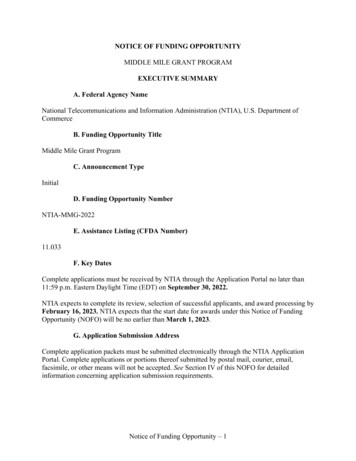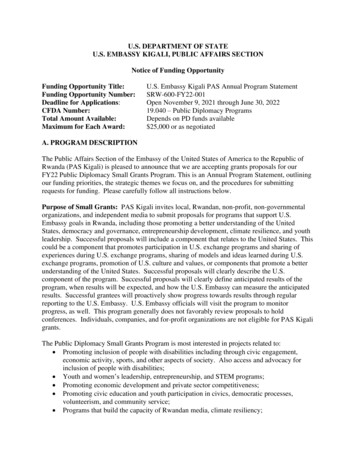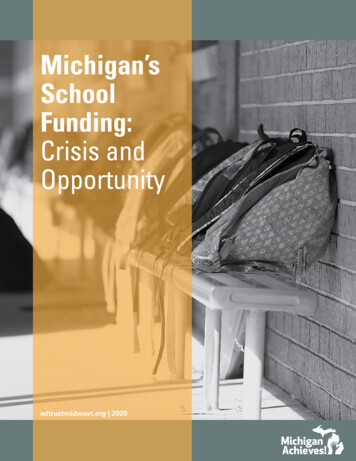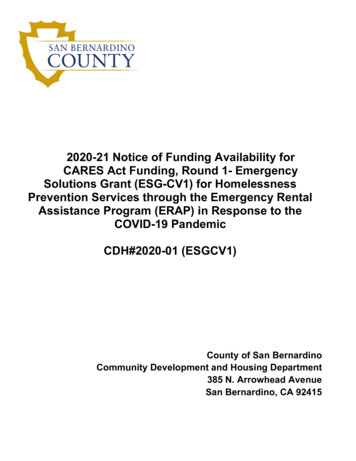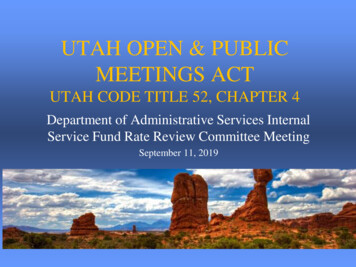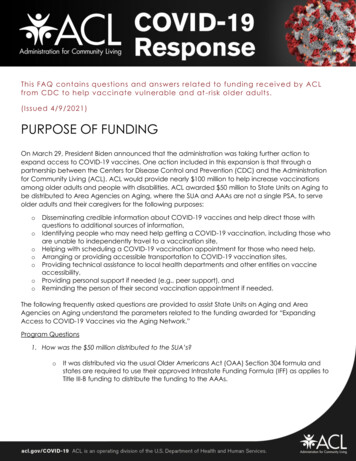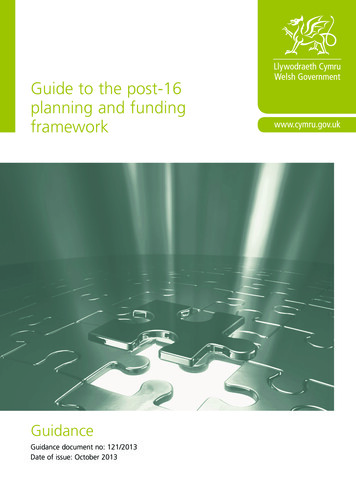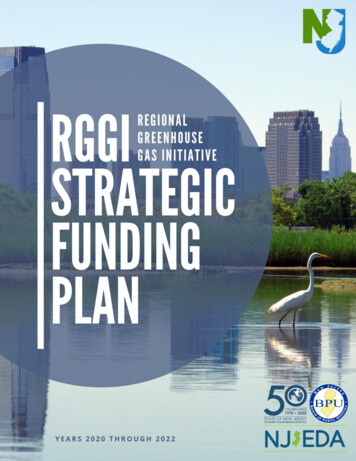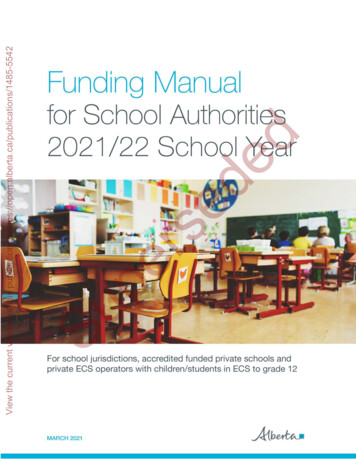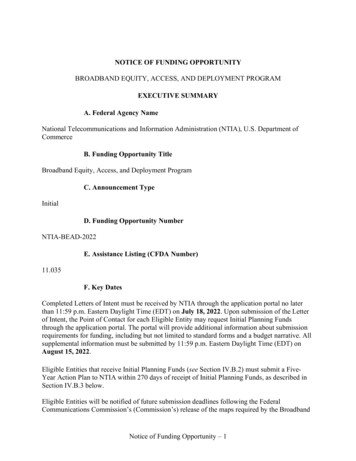
Transcription
NOTICE OF FUNDING OPPORTUNITYBROADBAND EQUITY, ACCESS, AND DEPLOYMENT PROGRAMEXECUTIVE SUMMARYA. Federal Agency NameNational Telecommunications and Information Administration (NTIA), U.S. Department ofCommerceB. Funding Opportunity TitleBroadband Equity, Access, and Deployment ProgramC. Announcement TypeInitialD. Funding Opportunity NumberNTIA-BEAD-2022E. Assistance Listing (CFDA Number)11.035F. Key DatesCompleted Letters of Intent must be received by NTIA through the application portal no laterthan 11:59 p.m. Eastern Daylight Time (EDT) on July 18, 2022. Upon submission of the Letterof Intent, the Point of Contact for each Eligible Entity may request Initial Planning Fundsthrough the application portal. The portal will provide additional information about submissionrequirements for funding, including but not limited to standard forms and a budget narrative. Allsupplemental information must be submitted by 11:59 p.m. Eastern Daylight Time (EDT) onAugust 15, 2022.Eligible Entities that receive Initial Planning Funds (see Section IV.B.2) must submit a FiveYear Action Plan to NTIA within 270 days of receipt of Initial Planning Funds, as described inSection IV.B.3 below.Eligible Entities will be notified of future submission deadlines following the FederalCommunications Commission’s (Commission’s) release of the maps required by the BroadbandNotice of Funding Opportunity – 1
Deployment Accuracy and Technology Availability (DATA) Act, Pub. L. No. 116-130, 134 Stat.228 (2020) (codified at 47 U.S.C. §§ 641-646) (Broadband DATA Maps). Initial Proposals maybe submitted immediately upon issuance of the Notices of Available Amounts described inSection IV.B.4.b and will be due to NTIA no later than 180 days after such issuance. FinalProposals will be due to NTIA no later than 365 days after the approval of the Initial Proposal bythe Assistant Secretary. See Section IV.B of this Notice of Funding Opportunity (NOFO) foradditional timeline and program sequencing information.G. Application Submission AddressComplete Letters of Intent, Requests for Initial Planning Funds, Five-Year Action Plans, InitialProposals, and Final Proposals must be submitted electronically through NTIA’s onlineapplication portal, available at https://grants.ntia.gov/. Complete program materials or portionsthereof submitted by postal mail, courier, email, facsimile, or other means will not be accepted.See Section V of this NOFO for detailed information concerning submission requirements.H. Funding Opportunity DescriptionNTIA issues this NOFO to describe the requirements under which it will award grants for theBroadband Equity, Access, and Deployment (BEAD) Program (Program), authorized by theInfrastructure Investment and Jobs Act of 2021, Division F, Title I, Section 60102, Public Law117-58, 135 Stat. 429 (November 15, 2021) (Infrastructure Act or Act) also known as theBipartisan Infrastructure Law. The BEAD Program provides new federal funding for NTIA togrant to all fifty states, the District of Columbia, and Puerto Rico (States), as well as AmericanSamoa, the Commonwealth of the Northern Mariana Islands, Guam, and the United States VirginIslands (Territories), and in certain circumstances political subdivisions of these States andTerritories, for broadband planning, deployment, mapping, equity, and adoption activities.Funding is distributed primarily based on the relative number of “unserved” locations (i.e.,broadband-serviceable locations that lack access to Reliable Broadband Service at speeds of atleast 25 Mbps downstream and 3 Mbps upstream and latency levels low enough to support realtime, interactive applications) in each State and Territory. Each State is eligible to receive aminimum of 100,000,000 and each Territory is eligible to receive a minimum of 25,000,000.See Section I of this NOFO for the full Program Description.I. Funding InstrumentGrant.J. EligibilityEligible Entities authorized to apply to NTIA for grants under the BEAD Program are the entitiesidentified in Section 60102(a)(2)(F) of the Infrastructure Act—specifically, any State of theUnited States, the District of Columbia, Puerto Rico, American Samoa, Guam, the U.S. VirginIslands, and the Commonwealth of the Northern Mariana Islands. See Section III of this NOFOfor additional information concerning the BEAD Program’s eligibility requirements.Notice of Funding Opportunity – 2
K. Anticipated AmountsEach State is eligible to receive a minimum allocation of 100,000,000. Each State may requestup to 5,000,000 of its minimum allocation in Initial Planning Funds. American Samoa, Guam,the U.S. Virgin Islands, and the Commonwealth of the Northern Mariana Islands each areeligible to receive a minimum allocation of 25,000,000. Each of those territories may request upto 1,250,000 of its minimum allocation in Initial Planning Funds. Not less than twenty percentof the total allocation for a State or Territory will be made available at the approval of the InitialProposal with remaining funds released upon approval of the Final Proposal.After the publication of broadband coverage maps being prepared by the FederalCommunications Commission (Broadband DATA Maps), which will be used to determine thenumber of unserved locations in every State and Territory, NTIA will notify Eligible Entities oftheir total funding allocations, calculated in accordance with Sections 60102(c)(1) and (c)(3) ofthe Infrastructure Act, and inclusive of the minimum initial allocation and Initial Planning Funds.See Section II of this NOFO for additional information pertaining to award amounts and to theperiod of performance for grants issued pursuant to this NOFO.L. Cost Sharing/MatchingExcept in certain specific circumstances described herein (including projects in designated“high-cost areas,” as defined in Section 60102(a)(2)(G), and other cases in which NTIA haswaived the matching requirement pursuant to Section 60102(h)(3)(A)(ii)), for each broadbanddeployment project utilizing BEAD grant funding, each Eligible Entity shall provide, require itssubgrantee to provide, or provide in concert with its subgrantee, matching funds of not less than25 percent of project costs. Funds from federal programs, including funds from theCommission’s Universal Service Fund programs, generally may not be used as matching funds;however, the Infrastructure Act expressly provides that matching funds for the BEAD Programmay come from a federal regional commission or authority and from funds that were provided toan Eligible Entity or a subgrantee for the purpose of deploying broadband service under theFamilies First Coronavirus Response Act (Public Law 116-127; 134 Stat. 178); the CARES Act(Public Law 116-136; 134 Stat. 281), the Consolidated Appropriations Act, 2021 (Public Law116-260; 134 Stat. 1182); or the American Rescue Plan Act of 2021 (Public Law 117-2; 135Stat. 4), to the extent permitted by those laws. See Section III.B of this NOFO for moreinformation pertaining to the cost sharing requirements for this Program.FULL ANNOUNCEMENT TEXTTable of ContentsI. Program Description . 5A. NOFO Structure . 5B. Overview . 6C. Definitions . 11Notice of Funding Opportunity – 3
II. Federal Award Information . 17A. Funding Availability . 17B. Period of Performance . 17C. Award Amount . 18D. Treatment of Unallocated and Unused Funds . 19E. Type of Funding Instrument . 19III. Eligibility Information . 19A. Eligible Applicants . 19B. Cost Sharing or Matching . 20IV. Program Structure, Sequencing and Requirements . 22A. Program Structure . 22B. Program Sequencing . 23C. Program Requirements . 50D. Subgrantee Qualifications . 71V. Application and Submission Information. 76A. Single Application. 76B. Address to Request Application Package. 76C. Content and Form of Applications . 76D. Certifications Regarding Debarment and Suspension . 76E. Unique Entity Identifier and System for Award Management . 80F. Submission Dates and Times . 81G. Intergovernmental Review . 81H. Funding Restrictions . 81I. Material Representations and Public Disclosure of Applications . 83J. Other Submission Requirements . 83VI. Application Review Information . 83A. Review Process for the BEAD Program . 84B. Federal Awarding Agency Review of Risk Posed by Applicants . 84C. Anticipated Announcement and Award Dates . 85VII. Federal Award Administration Information. 85A. Federal Award Notices. 85B. Notification to Unsuccessful Applications. . 85C. Retention of Unsuccessful Applications. . 85D. Administrative and National Policy Requirements . 86E. Reporting . 89F. Recipient Integrity and Performance Matters . 92G. Audit Requirements . 93H. Federal Funding Accountability and Transparency Act of 2006 . 93Notice of Funding Opportunity – 4
VIII. Federal Awarding Agency Contact(s) . 93IX. Other Information . 94A. Transparency . 94B. Protected and Proprietary Information . 94C. Funding Availability and Limitation of Liability. 95D. Third Party Beneficiaries . 95E. Waiver Authority . 96F. Paperwork Reduction Act and Administrative Procedures Act . 96G. Transparency, Accountability, And Oversight Required . 96H. Unauthorized Use of Funds. 98I. Program DescriptionThe National Telecommunications and Information Administration (NTIA) issues this Notice ofFunding Opportunity (NOFO) to describe the requirements under which it will award grants inconnection with the Broadband Equity, Access, and Deployment (BEAD) Program (Program),authorized by the Infrastructure Investment and Jobs Act of 2021, Division F, Title I, Section60102, Public Law 117-58, 135 Stat. 429 (November 15, 2021) (Infrastructure Act or Act) alsoknown as the Bipartisan Infrastructure Law. The BEAD Program provides federal funding forgrants to Eligible Entities for broadband planning, deployment, mapping, equity, and adoptionactivities.A. NOFO StructureThis NOFO presents information relevant to entities eligible for direct receipt of BEAD funding(i.e., States and Territories, referred to in the Infrastructure Act as “Eligible Entities”), as well asentities that may seek subgrants from those Eligible Entities to conduct the numerous activitiesthat are eligible uses for BEAD funding. It is generally organized as follows:Section I (Program Description) provides an overview of the BEAD Program, includingbackground material related to the Infrastructure Act broadly, as well as an overview of theProgram’s procedural framework. It then defines key terms used throughout the NOFO.Section II (Federal Award Information) provides basic information such as the amounts madeavailable under the BEAD Program, key dates, the circumstances in which the AssistantSecretary may grant extensions, and the treatment of unallocated and unawarded funds.Section III (Eligibility Information) describes entities eligible for BEAD Program grants(generally, States and Territories of the United States), requirements relating to the provision ofmatching funds by Eligible Entities and/or other actors, and circumstances that might warrantwaiver of the match requirements.Section IV (Program Sequencing, Structure, and Requirements) provides informationregarding the BEAD Program’s structure, describing in detail the nine principal steps in theNotice of Funding Opportunity – 5
process: (1) the Letter of Intent, (2) the Request for Initial Planning Funds, (3) the Five-YearAction Plan, (4) Program Fund Allocation and the Notice of Available Amounts, (5) the InitialProposal, (6) the Challenge Process, (7) the Subgrantee Selection Process, (8) the 20 PercentFunding Release, and (9) the Final Proposal and Release of Remaining Funds. NTIA urgesentities seeking to participate in the BEAD Program as Eligible Entities or as subgrantees toreview this section especially closely. NTIA plans to provide detailed technical assistance toEligible Entities regarding all matters addressed in this section.Section V (Application and Submission Information) sets out information regarding howEligible Entities may apply for and use BEAD Program funding, including a link to the onlineapplication portal, formatting instructions, certification requirements, submission timelines, andeligible uses for funding. It also provides information regarding certifications that prospectivesubgrantees must make in order to be eligible for subgrants.Section VI (Application Review Information) briefly describes the review process that NTIAwill undertake in assessing submissions by Eligible Entities in connection with the BEADProgram. 1Section VII (Federal Award Administration Information) explains the process NTIA willemploy to approve applications, notify successful and unsuccessful applicants of the process’sresults, and various legal obligations applicable to grant recipients (including, but not limited to,those relating to domestic procurement preferences (“Buy American” requirements) andcontracting with small and minority businesses, women’s business enterprises, and labor surplusarea firms).Section VIII (Federal Awarding Agency Contacts) provides contact information forindividuals to whom interested parties may direct inquiries regarding the BEAD Program.Section IX (Other Information) details information regarding topics including audit andreporting requirements, mandatory transparency, accountability, and oversight measures, andconsequences associated with the unauthorized use of BEAD Program funds.B. Overview1. BackgroundIn recent decades, access to the internet has played a critical and growing role in the ways inwhich Americans work, learn, receive health care, and participate in democracy. The COVID-19pandemic crystalized what many have known for a very long time: High-speed internet access isnot a luxury, but a necessity, for all Americans, regardless of their age, race, or income,irrespective of where they live, what languages they speak, what resources they have at theirdisposal, and what specific challenges they may face in their daily lives.Recognizing broadband’s fundamental role in today’s society and its centrality to our nation’scontinued health and prosperity, President Biden has pledged to make sure that every American1NIST is the entity within the Department of Commerce that will administer BEAD Program grants.Notice of Funding Opportunity – 6
has access to reliable, affordable, high-speed internet. Full participation in our twenty-firstcentury economy requires no less. Digital equity is necessary for civic and cultural participation,employment, lifelong learning, and access to essential services. Yet affordable, reliable, highspeed internet access has remained elusive to many for too long, because they live in a locationwhere no service is available, the speed or quality of the service available is unreliable, or theoffering available is unaffordable or inadequate. Internet connectivity itself is a necessary, butnot sufficient, condition for eradicating the digital divide. Many on the wrong side of that dividerequire equipment, digital skills, financial resources, and more to realize the internet’s fullpotential. Those who lack these resources face substantial barriers to digital equity, even inplaces where fast broadband connections are physically available. This digital divide isparticularly acute for communities of color, Tribal nations, and lower-income areas and spansboth urban and rural areas of the country.Passed on a bipartisan basis, the Infrastructure Act includes 42.45 billion to create the BEADProgram. The law charges NTIA—the President’s chief advisor on telecommunications andinformation policy matters, housed within the United States Department of Commerce (DOC)—with administering this program.This NOFO describes how, in partnership with other federal actors, as well as States, Territories,Tribal nations, cities, towns, counties and other localities, the non-profit sector, academia, unionsand worker organizations, and industry, NTIA intends to administer the BEAD Program. Thisprogram will lay critical groundwork for widespread access, affordability, equity, and adoptionof broadband, create good-paying jobs; grow economic opportunities, including for localworkers, provide increased access to healthcare services, enrich educational experiences ofstudents, close long-standing equity gaps, and improve the overall quality of life across America.The Program’s principal focus will be on deploying broadband service to unserved locations(those without any broadband service at all or with broadband service offering speeds below 25megabits per second (Mbps) downstream/3 Mbps upstream) and underserved locations (thosewithout broadband service offering speeds of 100 Mbps downstream/20 Mbps upstream).Eligible Entities that demonstrate they will be able to ensure service to all unserved andunderserved locations will be free to propose plans that use remaining funds in a wide variety ofways, but NTIA underscores its strong preference that Eligible Entities also ensure deploymentof gigabit connections to community anchor institutions such as libraries and community centersthat lack such connectivity. Eligible Entities can apply any additional funding to pursue eligibleaccess-, adoption-, and equity-related uses, as well as any other uses approved by the AssistantSecretary that support the Program’s goals.With respect to the deployment of last-mile broadband infrastructure, the Program prioritizesprojects designed to provide fiber connectivity directly to the end user. It also requires allprojects to provide a low-cost option to eligible subscribers, requires all states to have plans toaddress middle-class affordability, and further prioritizes proposals that improve affordability toensure that networks built using taxpayer dollars are accessible to all Americans. The frameworkset out below will provide Eligible Entities flexibility to pursue deployments in the manner bestsuited to their populations – including, for example, the deployment of Wi-Fi service withinmulti-family buildings.Notice of Funding Opportunity – 7
NTIA envisions and welcomes extensive coordination and cooperation with all relevantstakeholders. States and Territories have an important statutory role in the BEAD process.Localities and groups representing historically excluded communities can and must make theirvoices heard to ensure that longstanding equity gaps are finally closed. Existing broadbandproviders and new entrants must communicate well with Federal, State, Territorial, local, andTribal partners to ensure that deployments proceed as expected and that non-deploymentactivities are designed and implemented in ways that most benefit the communities they aredesigned to serve. And, of course, NTIA urges individual stakeholders to engage throughout theprocess—with NTIA, with State, Territorial, and Tribal Governments, with providers, and withcivil society groups—to ensure that this historic investment effectuates the purposes of theInfrastructure Act.2. Process OverviewSuccessful execution of the BEAD Program will require close collaboration between NTIA, asthe Program administrator, and the Eligible Entities, which must ensure that affordable, reliable,high-speed internet is accessible at every location within their jurisdictions and that other BEADProgram objectives are achieved. Eligible Entities, in turn, can succeed only by committing toclose and ongoing coordination with their political subdivisions, subgrantees, and outsidestakeholders, including current and prospective broadband providers, citizens, civil rights- andequity-focused organizations, community-based organizations, civil society and consumerfocused groups, unions and worker organizations, workforce boards, economic developmentorganizations, schools, community colleges, neighborhood and housing associations, and thecommunities that stand to benefit from these unprecedented investments.The Assistant Secretary and the staff of NTIA look forward to close communication during allphases of the process described in this NOFO. Broadly speaking, the process contemplated bythe Infrastructure Act and this NOFO is as follows:StageLetter of IntentDescriptionJuly 18, 2022 is the deadline for an Eligible Entity to submit a Letter ofIntent to participate in the Program.Request for InitialPlanning FundsEither with its Letter of Intent or afterwards, an Eligible Entity that is aState (including the District of Columbia and Puerto Rico) may requestup to 5,000,000 in Initial Planning Funds. American Samoa, Guam,the U.S. Virgin Islands, and the Commonwealth of the NorthernMariana Islands each may request up to 1,250,000. Each EligibleEntity’s Initial Planning Funds will be drawn from that EligibleEntity’s Minimum Initial Allocation. If the Eligible Entity requestsInitial Planning Funds, it must submit an application for InitialPlanning Funds by 11:59 p.m. Eastern Daylight Time (EDT) August15, 2022, and a Five-Year Action Plan within 270 days of receipt ofInitial Planning Funds.Notice of Funding Opportunity – 8
Notice of AvailableAmountsOn or after the date on which the Broadband DATA Maps are madepublic, the Assistant Secretary will notify each Eligible Entity of theestimated amount of funding that NTIA will make available to theEligible Entity under the Program (Notice of Available Amounts) andinvite the submission of an initial grant proposal (Initial Proposal) anda final grant proposal (Final Proposal).TechnicalAssistanceLeading up to submission of the Initial Proposal and throughout theremainder of the process, NTIA will provide support and technicalassistance to help ensure that the Eligible Entity’s proposals fully meetthe requirements of the Infrastructure Act and the goals of the Program.This technical assistance will include iterative feedback on draft Initialand Final Proposals.Initial ProposalEligible Entities will have 180 days from receipt of the Notice ofAvailable Amounts to develop and submit an Initial Proposal, whichwill, among other things, describe the competitive process the EligibleEntity proposes to use to select subgrantees to construct broadbandprojects. Prior to submission to NTIA, the Initial Proposal must bemade available for public comment, and the Initial Proposal mustincorporate local coordination feedback for the Assistant Secretary’sreview.Challenge ProcessAfter submission of its Initial Proposal and before allocating BEADfunds received for the deployment of broadband networks tosubgrantees, an Eligible Entity must conduct a challenge process.Under this process, a unit of local government, nonprofit organization,or broadband service provider can challenge a determination made bythe Eligible Entity in the Initial Proposal as to whether a particularlocation or community anchor institution within the jurisdiction of theEligible Entity is eligible for the grant funds, including whether aparticular location is unserved or underserved, and Eligible Entitiesmust submit any successful challenges to NTIA for review andapproval.Initial FundingAvailabilityNTIA will review Initial Proposals as expeditiously as possible. Oncean Initial Proposal is approved, NTIA will make available to theEligible Entity not less than 20 percent of the total grant fundsallocated to the Eligible Entity.SubgranteeSelectionAn Eligible Entity may initiate its competitive subgrantee selectionprocess upon approval of its Initial Proposal and will have up to oneyear to conduct additional local coordination, complete the selectionprocess, and submit a Final Proposal to NTIA. NTIA will providesupport and technical assistance to help ensure that the Final Proposalfully meets the requirements of the Infrastructure Act and the goals ofNotice of Funding Opportunity – 9
the Program. The Eligible Entity may, at this point, utilize the fundingprovided (not less than 20 percent of the Eligible Entity’s total grantfunds) to initiate certain eligible activities (see Section IV.B.8) beforesubmission and approval of their Final Proposals.Final ProposalAfter the Eligible Entity has selected subgrantees and otherwiseexecuted its approved Initial Proposal, it will submit to NTIA a FinalProposal describing how it complied with that Initial Proposal and theresults of its processes. NTIA will award the remaining funds allocatedto the Eligible Entity upon approval of the Eligible Entity’s FinalProposal, and Eligible Entities will initiate their subgrants for theremaining 80 percent of funding and any portion of the original 20percent that the Eligible Entity has not yet awarded as a subgrant. Priorto submission to NTIA the Final Proposal must be made available forpublic comment.OngoingMonitoring,Reporting, andPerformanceManagementThroughout the BEAD Program, NTIA will conduct ongoingmonitoring of an Eligible Entity’s progress against its plans and ensurethat the requirements of the Infrastructure Act are met. Eligible Entitieswill be required to comply with reporting requirements and monitorsubgrantee compliance.NTIA strongly encourages each Eligible Entity participating in the BEAD Program toconcurrently participate in the programs established under the Digital Equity Act of 2021, whichprovides 2.75 billion to further advance federal goals relating to digital equity and digitalinclusion. Just as the BEAD Program begins with a Five-Year Action Plan, the Digital EquityAct begins with State Digital Equity Planning Grants, which is the subject of a separate NOFO.Eligible Entities should view this NOFO and the State Digital Equity Planning Grant NOFO
This NOFO presents information relevant to entities eligible for direct receipt of BEAD funding (i.e., States and Territories, referred to in the Infrastructure Act as "Eligible Entities"), as well as entities that may seek subgrants from those Eligible Entities to conduct the numerous activities that are eligible uses for BEAD funding.
